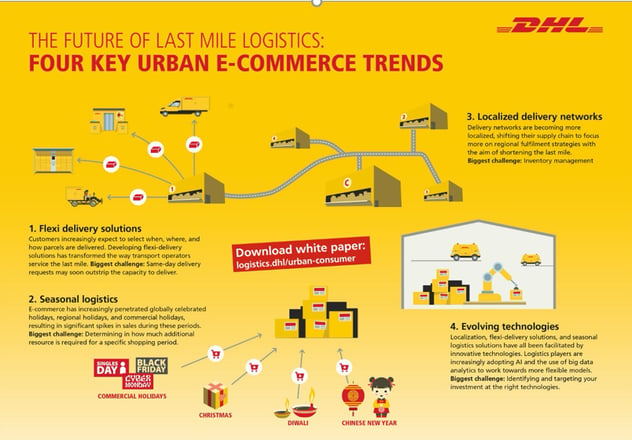As the world’s population grows, city living is becoming the norm for most. By 2050, 68% of the world’s population is projected to live in urban areas (source). Even today, megacities like New York (metropolitan areas with a population of more than 10 million people) congest traffic and provide a challenge for logistics. What can shippers do to adapt to these changes?
A study published by DHL reveals some key trends in urbanization and how it affects the supply chain. Here are a few key takeaways.
THE URBAN CONSUMER TODAY
Urban consumers today live in a densely populated, inter-connected and fast-paced environment. Technology affects them more than ever before – urban consumers are constantly connected to the internet. This means they can connect directly with businesses and increasingly are moving services to apps or websites – such as ride hailing, online food delivery, accommodation booking and centralized daily life management. Furthermore, they’re purchasing more online than ever before and thanks to Amazon’s 2-Day Shipping and MABD, they expect products quick. They make purchasing decisions impulsively and have a wide array of products to choose from, so they are quick to drop slow delivery service in favor of faster service.
KEY URBAN E-COMMERCE TRENDS
DHL identified 4 key urban logistics trends that affect the whole supply chain.

Flexi delivery solutions
Customers increasingly expect to select when, where, and how parcels are delivered. Developing flexi-delivery solutions has transformed the way transport operators service the last mile.
Seasonal logistics
E-commerce has increasingly penetrated globally celebrated holidays, regional holidays, and commercial holidays, resulting in significant spikes in sales during these periods.
Localized delivery networks
Delivery networks are becoming more localized, shifting their supply chain to focus more on regional fulfillment strategies with the aim of shortening the last mile.
Evolving technologies
Localization, flexi-delivery solutions, and seasonal logistics solutions have all been facilitated by innovative technologies. Logistics players are increasingly adopting AI and the use of big data analytics to work towards more flexible models.
WHAT NEEDS TO BE DONE?
Last-mile operations will evolve alongside the urban consumer. As DHL suggests:
Capturing delivery segments, aggressive management of expenses while operating under slim margins, utilizing technology whenever possible, and pursuing alternative labor models are all potentially decisive measures. If the industry is to follow through with these strategic shifts in the future, certain success factors need to be considered by all players. The industry first needs to sustain cost-efficiency in the e-commerce fulfillment field—maintaining profitability always has been a challenge and will continue to remain so. Service quality from leading industry players as well as service partners will also need to be monitored, without adding additional stress on staff by expanding their responsibilities.
These changes can be implemented through the use of a variety of supply chain tools. There is no one solution that will work for every company, but solutions include:
- Flexible Networks – Keeping delivery flexible by using the most efficient available transport capacity – including alternative ground transportation options such as bikes or vans.
- Automation – Automation in processing at fulfillment centers, but also the use of autonomous vehicles and robots
- Data Management – Managing data to better forecast and position inventory, to obtain a better availability of stock.
As urbanization continues and e-commerce deliveries become faster, the supply chain will bend and adapt. In the short term, you can implement some of these practices today to prepare for the future. Not sure where to get started? Our Freight Calculator is the first step to estimating delivery costs.
MVP Logistics is your 3PL logistics partner for supply chain project management, logistics, warehousing and fulfillment, LTL, and other supply chain needs. Our Minneapolis, Houston, and Los Angeles area warehouses provides local, national, and international shipping services. Find your solution today.
